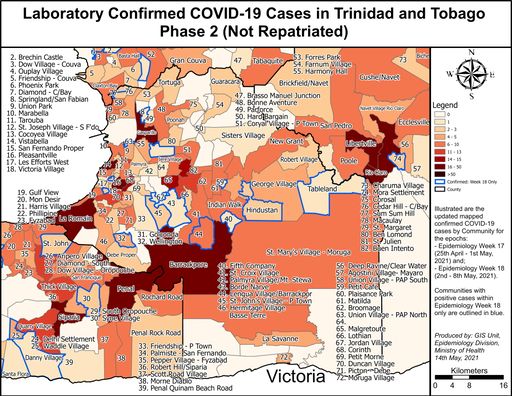(Trinidad Guardian) A grim milestone was recorded yesterday when, in the 24-hour period between Monday and Tuesday, 23 people lost their lives to COVID-19.
It means just under one person died every hour of a day in this country.
If that’s not enough cause for concern, 148 people died from COVID in the first 17 days of this months.
These startling statistics make May 2021 now deadlier than all of 2020. The 148 deaths recorded thus far, eclipse the total death toll for 2020, which was 127.
The daily reported death toll record is not one the country didn’t expect would break again, following 21 reported deaths on May 13.
For the fifth time for May 2021, Trinidad and Tobago reported a deadliest day for the pandemic, with a whopping 23 deaths reported yesterday.
With the newly-reported fatalities, the country’s death toll crossed the 300-mark in 10 days, now standing at 317. For comparison, it took 224 days from the first COVID-19 case to cross 100 deaths and 198 days to cross 200 deaths.
According to the ministry, 15 people who died had comorbidities, including five elderly females, two middle-aged females, seven elderly males and one middle-aged male. The remaining eight people did not have significant underlying medical conditions, including two elderly females, three middle-aged females, one elderly male and two middle-aged males.
T&T’s case-fatality rate for May is now at 2.34 per cent, meaning that at least two people may die for every 100 cases of COVID-19 T&T records. Comparatively, for the entire pandemic, the country’s case-fatality ratio is 1.85 per cent, while globally, it stands at 2.07 per cent.
Yesterday, the country reported 601 new COVID-19 cases, marking the second-highest jump in daily reported cases for the pandemic to date. These cases originated from samples taken during the 72 hours from May 13 through May 16.
The country’s total COVID-19 cases now stand at 17,150, with a record high of 6,318 cases considered active. Active cases include COVID-19-positive people isolated at home, in step-down facilities, or hospitals across the country.
Community spread means COVID-19 cases have spared no city, town, borough, or region across T&T. Based on the latest epidemiological data from the ministry, COVID-19 cases continue to be prevalent across the country’s population centres. However, between April 25 and May 8, Sangre Grande is the only area in the country where there are more than 50 cases within the boundaries of a community.
Across Nariva/Mayaro, St Andrew/St Davis, St George East, St George Central, St George West, Caroni and Victoria counties are 75 to 100 cases of COVID-19 per 10,000 people. The only counties lower are St Patrick, at 50 to 75 cases per 10,000 people, and Tobago, where there are 25 to 50 cases per 10,000 people.
Tobago’s active cases increased to a record high yesterday to 94 active cases with a daily record high of 25 cases reported in the last 24 hours.
Tobago’s hospital occupancy is at 33 per cent, with one patient in the Intensive Care Unit.
Hospitalisation occupancy levels remain high across the country. However, even with the increased deaths, recoveries and additional bed space, there has been minimal ease on the parallel healthcare system’s strain.
With a total of 387 in hospital, this marks the second-highest number of patients since the pandemic began, only one less than Monday’s 388.
The country’s overall COVID-19 hospital occupancy stands at 54 per cent across all levels of care in both islands, with a slightly higher 57 per cent when only accounting for Trinidad’s beds.
T&T’s parallel healthcare system now has a total of 720 hospital beds available. This count does not include the two military field hospitals, adding 40 beds each, located now at the Couva Hospital and Multi-Training Facility and the Jean Pierre Complex in Port-of-Spain.






